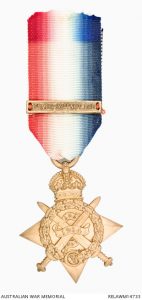The War Diary for the 2nd battalion, Manchester Regiment, contains entries on a great range of subject matter. Sometimes it provides information on casualties. On other days, it informs the reader that the men were able to take baths. On 5th February 1918, the General Officer Commanding 14th Infantry Brigade presented the medal ribbon of the 1914 Star to those entitled to receive it. Patrick was one of those men. A number of questions came to mind. Where did this take place? Who was the General? And how many men would have been recipients?
The ceremony took place at Emile Camp. Other War Diaries record the location of this camp as either at Elverdinghe or Boezinge. The two places are less than a mile apart, about four miles north west of Ypres. It seems safe to assume that the camp lay somewhere between the two villages. No trace of the camp remains today. I have scoured aerial photos looking for clues without success.
The man presenting the ribbons was (acting) Brigadier General Frederick William Lumsden. He started the War as a Major. It is clear that he led from the front. He landed in France in September 1914, and was thus entitled to wear the 1914 Star himself. 1917 is the year when his heroism became fully evident. At the beginning of January, he was awarded the DSO (Distinguished Service Order). For his actions on 3rd April, he was awarded the Victoria Cross. (He recovered some artillery pieces whilst under intense fire.) On 9th and 10th April, he earned bars to his DSO. He was awarded a third bar to his DSO in December of 1917. For good measure he was also Mentioned in Despatches eight times. He earned three major gallantry awards, including the highest of them all, in just eight days. Sadly, he did not survive the war. He was killed by a sniper in June 1918. He was certainly an appropriate choice to hand out medal ribbons.
I have left the most difficult question to last. The War Diary does not record a figure for that day in February 1918. 378,000 awards of the 1914 Star were made in total. Many of these were posthumous and were sent automatically to the next of kin. Others would have gone to wounded soldiers recovering at home. Some men would have been transferred to other units. I found a picture of the 2nd Battalion, Yorkshire Regiment that purports to show the 15 men who started and ended with that unit. A detailed analysis was made in the Black Watch (2nd Battalion). This study found 6 officers and 46 other ranks were left from the thousand that set off in August 1914. From my assessment of the units with which Patrick served, approximately one third were killed and two thirds were injured at some point. This makes the figures of 15 and 52 equally credible. What is clear is that there would not have been a long line of men queuing to receive their medal ribbons from General Lumsden.
